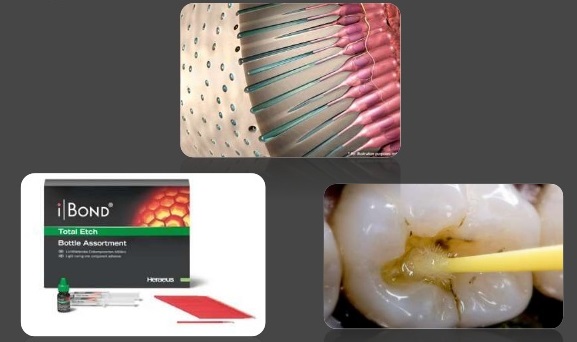Dentin bonding is an agent used as a material for combining composite restoration with dental tissue, specifically dentin. Dentin bonding is usually used in conjunction with composite resins to reduce the occurrence of microleakage between the filling material and the tooth surface, and increase the retention/adhesion of composite resins. Dentin bonding is very important to be used in carious and non-carious lesions involving large dentin surfaces, as well as in areas that are not supported by adequate enamel, such as the cervical area of the tooth.
Various necessary dentin bonding materials commonly used are HEMA, 4-META, EPDM, MMA, TEDGMA, and many others. One of the basic ingredients of dentin bonding that is busy to use is 4-META (4-methacryloyloxyethy trimellitate anhydride) because of its excellent retention properties. Besides the 4-META base material, dentin bonding also has an important component. It is the solvent which serves to help to thin the 4-META monomer and facilitate the penetration of monomers into dentin. The most commonly used solvents are ethanol, acetone, and water.
In its clinical application, all types of materials to be applied to living tissue must have excellent biocompatibility. It means the material can be accepted by the body, non-toxic, and not dangerous to living tissue. Meanwhile, there are some clinical phenomena that occur, such as postoperative pain after the deposition with composite resin preceded by the application of dentin bonding.
Several previous journals and studies mentioned that the residual monomers from imperfect polymerization of bonding materials were thought to be one of the causes of postoperative pain. Over time, it can cause fibroblast cells in dentinal tissue and dental pulp to experience death/necrosis.
The 4-META monomer is assumed to affect tissue causing cell death. The clinical phenomenon as described above is known because the 4-META monomer has a hydroxyl group (-OH), which is a form of free radical reactive compounds which are often called ROS (Reactive Oxygen Species). Free radicals in cells causing DNA damage will have an impact on cell activity disruption, causing cell death.
On the other hand, solvents also play an important role in the diffusion of monomers in dental tissue. Acetone as a solvent has a deficiency in neutralizing free radicals produced by 4-META monomers. Acetone is said to have a weak hydrogen bonding capacity, so the mechanism of anti oxi and free radical scavenging also does not occur optimally.
In this study, researchers aimed to determine the toxic nature of acetone based 4-META dentin bonding material against fibroblast cells in dental pulp tissue. Toxicity in fibroblast cells is seen from the number of cell deaths or necrosis. The chemical toxicity is usually expressed in LC 50 (Lethal Concentration). Toxicity test to 4-META-based acetone-coated dentin bonding was done to determine the toxic concentration of 4-META-coated dentin bonding material, which can cause 50% of dental pulp fibroblast cell death (LC 50 ).
Pulp fibroblast cell culture originated from human premolar teeth implanted in the media and incubated in an incubator. The cell is then transferred to a 96 well plate with 100 µl dentin bonding based on 4-META acetone coated with various concentrations (5000 μg / ml; 2500 μg / ml; 1250 μg / ml; 625 μg / ml; 312.5 μg / ml; 156 , 25 μg / ml; 78.12 μg / ml; 39.06 μg / ml; 19.53 μg / ml; and 9.76 μg / ml) and two wells were not treated as controls .
Citoxicity test was performed and the percentage of fibroblast cell deaths was calculated using the formula. The results showed that the concentration causing fibroblast cell death by 50% (LC 50 ) is 1250 µg / ml. It can be interpreted that the toxic concentration of acetone-coated dentin bonding base material is at a concentration more than or equal to 1250 µg / ml whereas concentrations below 1250 µg / ml are safe concentrations for dental pulp fibroblast cells.
By knowing the minimal toxic concentration of this dentin bonding material, the dentists and researchers are then expected to know the safe concentration of the 4-META aceton based solvent material used as dentin bonding. This research is expected to be the guideline for dentists to choose which dentin bonding material is safer for dentin tissue and its surroundings to minimize the toxicity arising from the dentin bonding material. (*)
Author : Adioro Soetojo, Dewi Purnama, Cecilia G.J Lunardhi, Ira Widjiastuti
Details of this research available at:
Adioro Soetojo, Dewi Purnama, Cecilia G.J Lunardhi, Ira Widjiastuti (2019). Cytotoxicity Test of 4-Methacryloxyethyl Trimellitic Anhydride–based Dentine Bonding Material Using Acetone Solution in Dental Pulp Fibroblast. Journal of International Oral Health, 11(4): 191-196; DOI:10.4103/jioh.jioh_32_19





